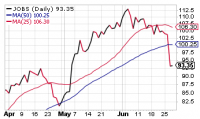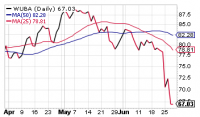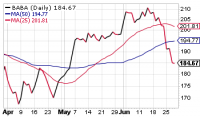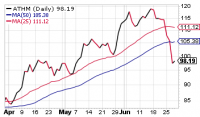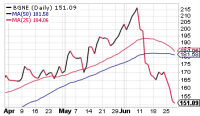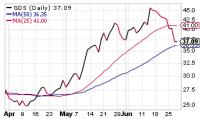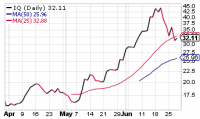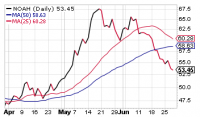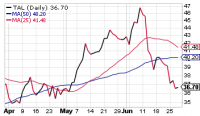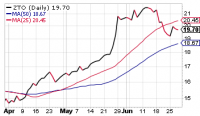With the MSCI Emerging Markets Index headed steeply down since June 13, we have been moving quickly to cut our exposure and kick losers out of our portfolio. It’s not pleasant, but it’s the only way to stay profitable in a volatile sector like emerging market stocks. Today’s bounce in the markets was a welcome relief from the selling pressure, but we will discount the good news until the Cabot Emerging Markets Timer gives us the all-clear.
Cabot Emerging Markets Investor 662
[premium_html_toc post_id="152658"]
Cabot Emerging Markets Timer
The Emerging Markets Timer is our disciplined method for staying on the right side of the emerging markets. The Timer is bullish when the index is above the lower of its two moving averages and that moving average is trending up.
Our Emerging Markets Timer remains clearly negative, with the downtrend accelerating in recent days. The iShares EM Fund (EEM) has been bumping downhill for months, but in the past couple of weeks the selling pressure has been more intense, driving the fund to new lows. And this leg down has even taken the formerly resilient Chinese stocks along with it.
Obviously, a bounce is possible after such a big drop, but with the trend firmly down, it’s time to play defense. That means keeping losers and laggards on tight leashes, holding plenty of cash and patiently waiting for a real uptrend to emerge.
The Current Unpleasantness
There’s not much pleasure to be taken from having been so timely in my warning about a possible downturn in the market. In my sermon in last Thursday’s Update, I said that “markets like to make people look smart for a while. But only for a while.”
So here we are a week later with Chinese ADRs underperforming the broad emerging markets index (a reversal of the trend for most of 2018), three stocks sold out of the portfolio and most of our other holdings under selling pressure. The portfolio’s cash position has ballooned to 50% and may get larger still as investors flee growth stocks in general and Chinese issues in particular.
Most of the blame for this correction goes to fears of a possible trade war between the U.S. and China (and also many of our traditional allies), but not all. When investors get genuinely alarmed about one negative idea, the other negative ideas that they have been discounting can build up, forming a pearl of irritation.
So the rising interest rate environment, political bitterness, rising national and corporate debt (including China’s debt load) and the elimination of several favorite teams from the World Cup competition can combine to produce a real downtrend.
The trade war is still the biggest fear, and it has been hitting native Chinese stocks as well. Here’s a daily chart of the Shanghai Stock Exchange, which seems to be paralleling the decline of iShares MSCI EM ETF (EEM) as Chinese investors worry about trade wars, national debt and the decline of the Chinese currency to its weakest value versus the U.S. dollar since December 20 of last year.
But the big message today is that, no matter what the reason(s) for a decline in the stock market and no matter what our personal opinions may be about how long or how deep a correction may go, the way to deal with a correction is to cut down or quit buying and tighten your loss limits and mental stop on the stocks in your portfolio. Those two steps are the only things a long-only growth investor can do. (For those who want to be more active, shorting issues and using options are available, though like most tools, they can do more harm than good if you don’t know what you’re doing.)
As I tell anyone who asks, Cabot’s growth disciplines use the direction of the market in the same way sailboats use the wind and tides. And when both the winds and tide are against you, it’s probably best to keep your anchor on the bottom and ride it out.
If you take a look at the Shanghai Stock Exchange chart above, you can see that the index, which has mostly stayed within shouting distance of its 25-day (red) and 50-day (blue) moving averages during its decline from its January highs, is now almost 9% below its 50-day moving average. Meanwhile, EEM is 7.2% below its 50-day and the Golden Dragon (PGJ) that tracks Chinese ADRs is just 4.7% below its 50-day, but 7% below its 25-day.
All in all, these measures lend credence to the idea that the indexes are oversold, and are likely to rebound, at least in the short term. There’s nothing to say that they can’t keep going down in the long run, but the selling looks overdone right now. The strength of the next bounce could provide a clue going forward.
As always, we will let the Cabot Emerging Markets Timer keep us in step with the market’s intermediate-term trend, and right now, that’s telling us to step lightly and reduce exposure.
Featured Stock
We’re Number Two!
JD.com (JD)
The company I’m writing up today—JD.com (JD)—gets a lot of headlines and kudos from analysts, but not a lot of love from investors. I think it’s important to figure out why that is, and I believe a comparison of JD.com with Alibaba will shed a lot of light.
JD.com is an online retailer, firmly entrenched in the #2 spot in China with about a 25% market share, trailing Alibaba (which has roughly 50%) by a wide margin but also well ahead of whoever is #3 (probably electronics retailer Suning with less than 5%). JD.com has a market cap of $55.8 and has annual sales of $57.8 billion. Alibaba’s market cap is $494 billion and its annual sales are $37.6 billion.
The divergence between Alibaba’s much larger ratio of market cap to annual revenue is a product of its business plan, which is to provide an online venue for buyers and sellers to meet and do business and take a cut of each transaction. JD.com’s business plan is to own, store and deliver the goods it sells. It’s a more capital-intensive enterprise, given the cost of inventory and warehousing, and the additional costs keep JD.com’s after-tax profit margins around 10%, while Alibaba’s average closer to 30%.
JD.com has always been a very ambitious company, taking the Amazon path of plowing cash flow into expansion and innovation while paying less attention to earnings. The company built out its warehouse and delivery infrastructure (including first and last mile services) right from the start. Today, the company delivers about 90% of its merchandise on a same-day or next-day basis. While Alibaba made headlines (and caught our eye) with its big investment in ZTO Express a few weeks ago, JD.com is likely still the leader in first- and last-mile delivery race. JD.com is also investing heavily in warehouse automation, drone delivery and self-driving vehicle technology.
The number of active JD.com customers has soared from 12.5 million in 2011 to 47.4 million at the end of 2013 and is now estimated at over 300 million.
JD.com has its own buying event to rival Alibaba’s Singles Day extravaganza. JD.com’s version is called 6.18 (because it runs for 18 days in June, and centers on the firm’s anniversary), and it’s a program of pop-up stores in 30 cities across China, discounts, flash sales and coordination of online, offline and virtual shopping experiences. This year’s 6.18 hit a new record transaction volume of $24.7 billion, virtually matching the $25 billion in spending during Alibaba’s 2017 Singles Day spending spree. (Alibaba, which doesn’t miss a trick, also participates in 6.18.)
JD.com also has a potential catalyst for improved perception in the form of a cash investment of $550 million from Google on June 18. JD.com has reportedly been assembling funding for an expansion program, looking to offer goods in the U.S. and Europe through Google Shopping. This would be a direct counter to Alibaba’s AliExpress program for sales outside China and its Lazada e-commerce program in Southeast Asia. Google’s position as the top search engine in major Southeast Asian markets could be a major plus for JD.com if Google integrates it into its search platform.
JD has done well since its IPO at 19 in May 2014, but except for a 77% rally from 25 in January 2017 to 46 at the end of July, the stock hasn’t made any decisive moves higher. A pop to 49 in August was followed by a correction to 37 in November and another new high at 51 in January 2018 rolled over to 36 at the start of this month.
The net effect of JD’s recent price action is that it’s still trading at 39, which was also its price in May 2017. That’s a long time of no net progress, even if the stock has been much higher over the 13 month period.
Right now, JD is caught up in the mini-panic of investors trying to calculate the probability and consequences of a possible trade war between China and the U.S., but that won’t last forever. I’ll put the stock on the watch list because I think there’s room in Chinese retail for more than one stock, and JD looks like a good bet when the dust settles from the global trade melee. WATCH.
JD.com (JD)
Building A
20th Floor No.18 Kechuang
11 Street Yizhuang Economic
and Technological Development Zo
Beijing 101111
China
http://www.jd.com
Model Portfolio
Invested 50% Cash 50%
Updates
Whereas the past month or two has been a mixed bag for emerging market stocks—most Chinese stocks were acting well, Brazilian stocks were getting hammered, and the rest of the EM universe was in the middle—the sellers have taken control during the past week, with many stocks cracking their intermediate-term uptrends.
In response, we’ve raised cash—we sold WUBA and our remaining half position in TAL on a Special Bulletin on Monday, and yesterday let go of MOMO, which has fallen sharply. We’ve also placed most of our stocks on Hold. All in all the portfolio is now sitting on a large 50% in cash, which gives us a cushion to withstand further declines, as well as buying power when the next uptrend gets underway.
Going forward, we’re keeping an open mind, especially as many stocks are still in decent shape. But the onus is clearly on the bulls to step up and arrest this decline. Tonight, we have no more moves given our big (60%) cash hoard, but we’re moving a bunch of stocks to Hold to respect our market timing.
51Job (JOBS) has had a big run since the start of March, and yesterday’s large-volume drop below the 50-day line puts a kibosh on that move. That said, the major trend is up and the correction is reasonable on the stock’s chart. Fundametnally, there is probably more risk here than with some other firms, given that any slowdown in the economy could dent China’s job market, but it’s way too early for that. We’ll change our rating to Hold, and will give the stock a little wiggle room to see if it can round out a new base. HOLD A HALF.
58.com (WUBA) was holding within its trading range, but the market’s weakness of late has changed that—shares plummeted through their long-term 200-day line on Monday and have skidding much more since then. We sold on that 200-day break on Monday’s Special Bulletin. SOLD.
Alibaba’s (BABA) breakout failed this week, with shares slipping back into the middle of its base; if you bought at higher prices, we’d be careful here, with either a very tight mental stop or even considering letting shares go on a weak rally. If you have a profit, though, we’d sit tight—longer-term, we think BABA likely has another leg up at some point, but the items in the news these days (trade war etc.) have proven too much for the stock to handle. We’ll go back to Hold here and wait patiently for the buyers to re-emerge. HOLD.
Autohome (ATHM) is also being moved to Hold today because of its recent action—after remaining mostly above its 50-day line all year, the stock plunged through that support on heavy volume yesterday. That said, we’re not throwing in the towel here, as ATHM’s story is excellent, long-term trend is firmly up and the recent pullback, while unpleasant, isn’t abnormal. If you own some, hold on. HOLD.
If the portfolio were light on cash, we’d probably have sold BeiGene (BGNE) recently. But with 50% on the sideline, and with the stock coming into an area of support, we’re going to stick with it for the moment. This isn’t a stock with sensitivity to economic conditions. We’ll stay on Hold. HOLD.
GDS Holdings (GDS) broke out around 32 in early May and quickly ran to 46. Thus, the recent dip to 36 or so (right at its rising 50-day line) is acceptable action. Of course, the story hasn’t changed, and trade war or no, demand for GDS’ data center offerings are sure to mushroom in the quarters ahead. If you don’t own any, we’re OK nibbling here. BUY.
iQIYI (IQ) has come back down to earth like every Chinese stock. Our thoughts here are two-fold: First, after a huge run and steep, big-volume correction, IQ likely needs time to consolidate at the very least. But second, we can’t say the decline is abnormal considering the overall advance. Long story short, we’re going to hang onto our half position in IQ here, giving it a chance to bottom and build a new launching pad. We will downgrade the stock to Hold, though, to respect the recent action and our market timing. HOLD A HALF.
Momo (MOMO) was a disappointment, but it’s reflective of what we’re seeing across the market these days (both U.S. and emerging markets)—the stock had a great-looking base, huge breakout and excellent upside follow-through, not to mention a positive reaction to earnings and excellent fundamental growth. But that breakout has effectively failed, with MOMO giving up all of its gains on big volume, partially due to a short-selling attack but mostly (we think) due to the market environment. We cut our loss short in a Special Bulletin last evening. SOLD.
Noah Holdings (NOAH) doesn’t look great, and normally that would cause us to scratch it off our Watch List. But given the fact that everything has circled the drain during the past week (and that Noah’s business is linked to the health of the financial markets), we’ll keep watching it to see how strong the stock’s next rebound is. (In fact, that will be a key for every stock—you want to focus on stocks that bounce back strongly, not those that can’t get off their knees.) WATCH.
TAL Education (TAL) was looking fine until three weeks ago, when a short seller’s attack whacked the stock. Initially, the decline was reasonable, but as the market has faded recently, TAL has stretched lower. We decided to take the profit on our remaining half position on Monday’s Special Bulletin. SOLD.
ZTO Express (ZTO) has pulled back with everything else, but we’re leaving it on Buy here—the drop is very reasonable compared to the stock’s prior advance, and the 50-day line (now at 18.7 and rising) should offer some support. Moreover, the stock just got going from a huge post-IPO base, and Alibaba’s big investment (and the huge underlying story—ZTO is the FedEx of China) should attract dip buyers. We’re OK buying a half-sized position here if you don’t own it; on the downside, a drop to the low to mid-17s would be abnormal. BUY A HALF.
[premium_html_footer]
Send questions or comments to paul@cabotwealth.com.
Cabot Emerging Markets Investor • 176 North Street, Salem, MA 01970 • www.cabotwealth.com
All Cabot Emerging Markets Investor buy and sell recommendations are made in issues or updates and posted on the Cabot subscribers’ website. Sell recommendations may also be sent to subscribers as special alerts via email. To calculate the performance of the hypothetical portfolio, Cabot “buys” and “sells” at the midpoint of the high and low prices of the stock on the day following the recommendation. Cabot’s policy is to sell any stock that shows a loss of 20% in a bull market (15% in a bear market) from our original buy price, calculated using the current closing (not intra-day) price. Subscribers should apply loss limits based on their own personal purchase prices.
THE NEXT CABOT EMERGING MARKETS INVESTOR ISSUE IS SCHEDULED FOR July 12, 2018
We appreciate your feedback on this issue. Follow the link below to complete our subscriber satisfaction survey: Go to: www.surveymonkey.com/chinasurvey
Cabot Emerging Markets Investor is published by Cabot Wealth Network, an independent publisher of investment advice since 1970. Neither Cabot Wealth Network, nor our employees, are compensated in any way by the companies whose stocks we recommend. Sources of information are believed to be reliable, but they are in no way guaranteed to be complete or without error. Recommendations, opinions or suggestions are given with the understanding that subscribers acting on information assume all risks involved. © Cabot Wealth Network 2018. Copying and/or electronic transmission of this report is a violation of the copyright law. For the protection of our subscribers, if copyright laws are violated, the subscription will be terminated. To subscribe or for information on our privacy policy, visit www.cabotwealth.com, write to support@cabotwealth.com or call 978-745-5532.
[/premium_html_footer]





